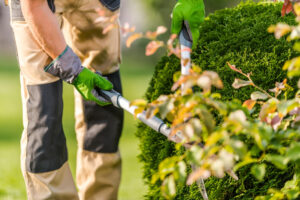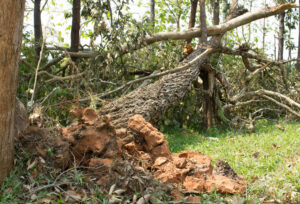Portland is known for its trees and rainy weather, but when storm season rolls in, that combination can cause real problems for homeowners. Strong winds, heavy rainfall, and soaked soil can all turn healthy-looking trees into serious safety hazards overnight. One weak limb or a leaning trunk can do thousands of dollars in damage, block driveways, or take down power lines.
The best way to protect your home, your family, and your property is to prepare early. At Monkeyman’s Tree Service, we’ve helped homeowners and businesses across Portland and surrounding areas keep their trees healthy and storm-ready for more than a decade. Here’s how to make sure your property is safe long before the next big storm hits.
Start with a Full Tree Health Check
Your trees often show warning signs long before they become dangerous. Take a slow walk around your property before storm season begins and look closely at each tree.
Check for deep cracks in the trunk, long hanging branches, or signs of decay like mushrooms growing near the base. Look for exposed roots or sudden leaning, especially after heavy rain. These are signs that your tree may not be stable.
If you notice anything unusual, don’t wait. A certified arborist can inspect the tree’s structure and decide whether it needs pruning, bracing, or removal. Early attention is much safer and less expensive than calling for emergency removal after a storm.
Know the Rules Before You Trim or Remove
In Portland, you can’t just remove a tree because it looks risky. The city’s Urban Forestry Division has specific rules that protect trees within residential and commercial areas. Many removals, especially large trees or those close to sidewalks, require a permit from the Bureau of Development Services (BDS).
Certain trees, such as Heritage Trees and street trees, are protected and have stricter requirements. Failing to follow those rules can lead to costly fines or stop your project entirely.
Monkeyman’s Tree Service is familiar with the process and can handle the paperwork for you. We’ll make sure your project stays compliant so you can focus on keeping your property safe.
Treating Tree Damage After a Storm
Once a storm passes, you may be left with fallen branches or damaged trees. The first step is safety keep everyone clear of unstable trunks or branches touching power lines. Never climb a damaged tree or use chainsaws without the right equipment and experience.
Many storm-damaged trees can be saved. If less than half the branches are broken and the trunk is still sound, pruning and support cables can often restore the tree. But if the roots have been pulled out of the ground or the trunk is split, removal may be the only safe option.
When cutting or trimming damaged wood, avoid sealing the wounds with tar or paint. Trees naturally heal themselves through a process called compartmentalization, where new wood grows around the damaged area. Keep the edges of cuts clean, and let air and sunlight help the tree recover.
Helping Trees Heal Naturally
Healthy trees are built to bounce back. After a storm, they focus on sealing off damage and redirecting growth to strong branches. You can help by giving them the right care.
Water deeply during dry weeks, add a layer of mulch around the base to retain moisture, and avoid piling soil or mulch directly against the trunk. Don’t over-prune; cutting too much can stress the tree even more.
If you’re unsure whether a damaged tree can recover, Monkeyman’s arborists can evaluate its structure and root stability. We’ll give you clear options for care or removal, depending on safety and long-term health.
Does Insurance Cover Tree Removal After a Storm?
This is one of the most common questions homeowners ask us. The answer depends on where the tree falls and what it hits.
If a tree damages your home, garage, or fence, your homeowners’ insurance typically covers the cost of removal and repairs. But if it falls in your yard without damaging a structure, cleanup costs are usually not covered.
If your neighbor’s tree falls on your property, your own insurance usually handles the cleanup unless the neighbor ignored a known hazard. Always take clear photos of the damage before starting cleanup, and contact your insurance company for guidance.
Monkeyman’s Tree Service can also help with insurance documentation and safe debris removal, so you don’t have to handle it alone.
The Right Time to Trim Trees in Portland
Knowing when to trim your trees is just as important as knowing how. Pruning at the wrong time can stress the tree or slow recovery.
In Portland, avoid trimming from late fall through winter (October to February). Cold and wet conditions slow down healing and make trees more vulnerable to decay. The best months for pruning are May through July, when the weather is mild and dry.
If you need light trimming in October to remove small branches, that’s fine. But save heavier cuts for spring or early summer.
When pruning, follow the simple 1-2-3 rule:
- Make the first cut on the underside of the branch, a few inches from the trunk.
- Make the second cut from the top, further out, to remove the branch safely.
- Finish with a clean cut just beyond the branch collar, without cutting into the trunk.
This prevents bark tearing and helps the tree close the wound naturally.
Local Tree Laws and Neighbor Responsibilities
Portland’s tree laws can be confusing, especially for trees growing along property lines. You are allowed to trim branches that hang over your property, but only up to the boundary line and without damaging the tree.
You cannot cut or remove a neighbor’s tree without permission, even if roots or branches cross into your yard. There’s no official height limit for trees, but if a neighbor’s tree is clearly unsafe, the city may step in to inspect it.
If your neighbor’s healthy tree falls during a storm, it’s considered an “Act of God,” and your insurance usually handles cleanup. However, if neglect was involved, the neighbor could be held responsible.
Monkeyman’s team understands Portland’s local tree codes and can help you navigate disputes safely and professionally.
Handling Tree Limbs and Debris After a Storm
Storm cleanup can be overwhelming. A single large tree can produce a huge amount of debris. The safest and fastest way to handle it is to bring in a professional crew, but here are a few tips if you plan to start the process yourself:
- Bundle small branches for the city’s yard debris collection.
- Take large debris to local facilities like Metro Central Transfer Station.
- Reuse wood chips or mulch if possible.
- Avoid burning debris; it’s unsafe and often illegal within Portland city limits.
Monkeyman’s provides full-service storm cleanup, including branch removal, hauling, and recycling. We’ll make sure your yard is safe and completely cleared.
How Much Does Cleanup Cost?
Cleanup costs depend on the size of the tree, accessibility, and the urgency of the job. Small branch pickup may cost less than a hundred dollars, while larger removals requiring cranes or heavy equipment can cost more. Emergency calls during or right after a storm also come with higher rates because of increased demand.
Scheduling regular maintenance before storm season can help you avoid these costs. Preventive pruning is always cheaper than emergency removal.
Two Things You Should Never Do After a Storm
After a storm, it’s tempting to try fixing things right away, but two common mistakes can make things worse.
First, never climb or cut unstable trees. Even small shifts in weight can cause major injury or property damage. Second, don’t wait too long to call for help. Leaning or cracked trees can fall days after a storm, especially when the ground stays wet.
Calling a certified arborist immediately after a storm is the safest decision. We’ll assess the damage, handle the cleanup, and make sure your trees and property are secure.
Prepare Your Property with Monkeyman’s Tree Service
Every winter, Portland’s storms test the strength of our city’s trees. Preparing your property now can prevent costly damage later. At Monkeyman’s Tree Service, we provide professional inspections, trimming, removal, and cleanup across Portland, Beaverton, Tigard, Gresham, and Vancouver, Washington.
Our certified arborists understand local tree species, Portland’s soil conditions, and the weather challenges that come with every season. We use safe, efficient techniques to protect your property and keep your landscape healthy year-round.
If you’re ready to get your trees storm-ready, contact Monkeyman’s Tree Service today. Schedule your free inspection or request an estimate at monkeymans.com or call (503) 730-3632.
With the right care and preparation, you can enjoy Portland’s storm season knowing your property and your trees are safe.


